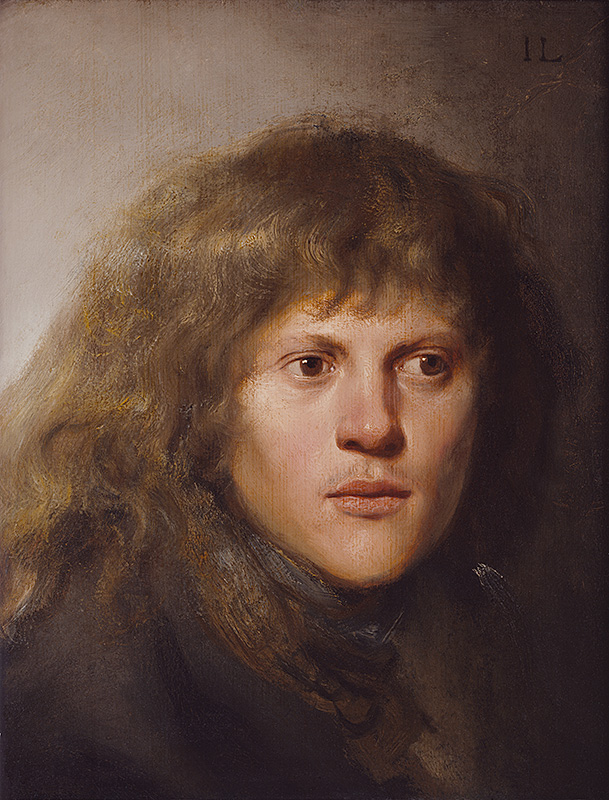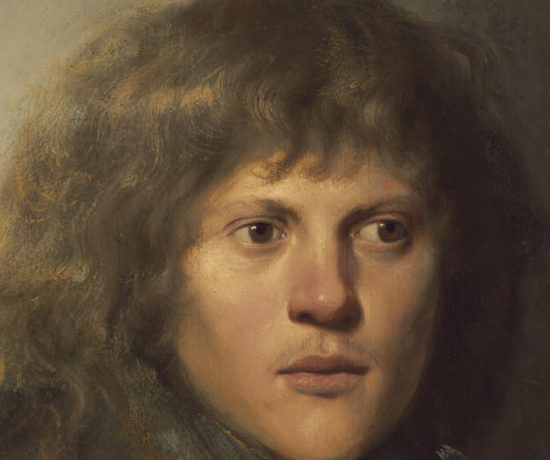When Constantijn Huygens (1596–1687), secretary to the prince of Orange, traveled from The Hague to Leiden in October 1628 to meet Jan Lievens and Rembrandt van Rijn (1606–69), he discovered two young artists whose striking personalities and artistic predilections he perceptively characterized in the diary entry he wrote shortly thereafter. As for Lievens, Huygens celebrated him as a prodigy and admired his “vigorous, untamable spirit” and “acute and profound insight into all manner of things,” even as he lamented the young artist’s stubbornness and excess of self-confidence. He admired Lievens’s work ethic and his choice of “audacious themes and forms.” If Huygens felt that Rembrandt was superior to Lievens in his “inventiveness, his sure touch and liveliness of emotions,” he also felt that Lievens was the better of the two in painting the human countenance, where “he wreaks miracles.”1
In this striking Self-Portrait, which Lievens probably began shortly after Huygens’s visit, one can understand entirely the power of the young artist’s forceful personality. Unlike Rembrandt, who in his early self-portraits of around 1629–30 often stared directly at the viewer but with part of his face obscured in shadow, Lievens sought no such effect. His piercing eyes gaze to the right, suggesting an active and searching mind. He further enlivened his image by painting his long, flowing brown hair with strikingly free and spontaneous brushstrokes. The light that falls from the upper left also illuminates his smooth skin, broad cheek bones and strong features, which he defined with carefully controlled strokes. He defined the proper right eye socket with a rhythmic sequence of parallel brushstrokes that indicate both structure and reflective light. The delicacy of his touch is also evident in the way he has articulated the fine hairs of his pencil-thin moustache.
The remarkable expressive qualities of this Self-Portrait raise many questions about Lievens’s artistic aspirations at this early stage of his career. They demonstrate a level of personal refinement and elegance entirely unexpected from the bold Caravaggist paintings he was making in the late 1620s. They also differ from the careful descriptive modeling of his tronies and other bust-length images from the same period, including his portrait of Rembrandt (fig 1). One cannot help but think that the character of this painting, which has unmistakable affinities to Van Dyck’s fluid style, owes something to the Leiden artist’s desire to evolve his style in a manner that would appeal to a courtly culture, whether in The Hague or London.2 Constantijn Huygens, who was the arbiter of taste at the Dutch court, greatly admired the paintings of Peter Paul Rubens and Anthony van Dyck. Indeed, Van Dyck came to The Hague to paint the portraits of Prince Frederick Hendrick and his consort Amalia van Solmes shortly after Lievens painted this Self Portrait.3 While in The Hague he also painted a portrait of Lievens, an indication of their mutual esteem. The portrait, now lost, is known today through an engraving that Lucas Vosterman (1595–1675) made for the Iconographia (fig 2).4
The Van Dyckian character of this Self-Portrait led earlier scholars to date this work around 1632–34, when Lievens was in England; nevertheless, a date of 1629–30 is probable for both stylistic and technical reasons.5 Dendrochronological examinations have revealed that Lievens used an oak panel made from the same tree that supplied the panel for Rembrandt’s Samson and Delilah in Berlin, which dates ca. 1629–30.6 This evidence indicates that Lievens and Rembrandt purchased their panels from the same panel maker, and perhaps that they even purchased their panels jointly.
X-radiographs indicate that Lievens made transformative revisions to his appearance during the course of the painting’s execution (fig 3). Lievens eliminated a hat, probably a painter’s beret, that he initially had placed tilted slightly forward on his head, and in its place added freely rendered, flowing locks at the left, perhaps in emulation of English or Flemish courtly hair styles. These changes strengthened his presentation into a dashing, almost aristocratic young man who peers out past the viewer, although he had already left behind his Leiden persona in anticipation of the career he hoped would soon unfold at the court of King Charles I in London.

